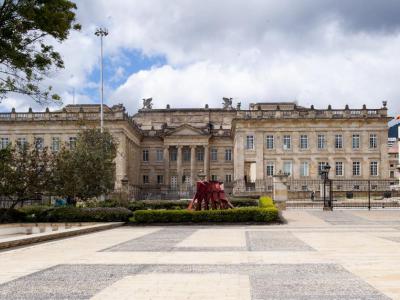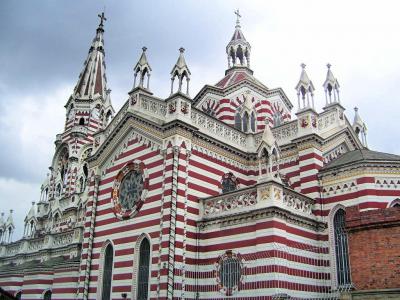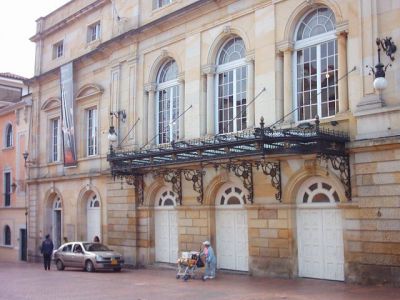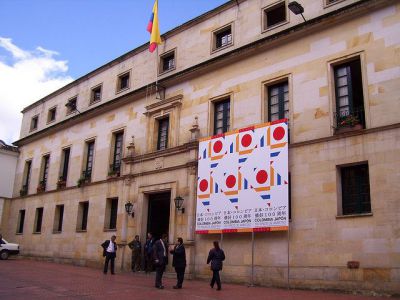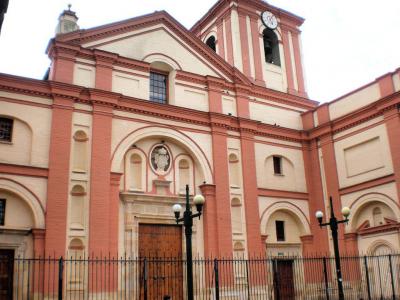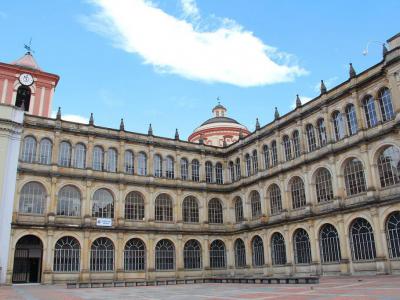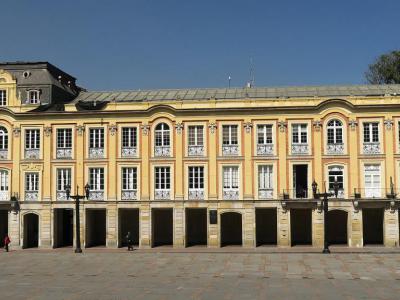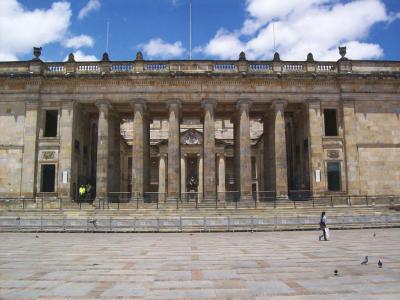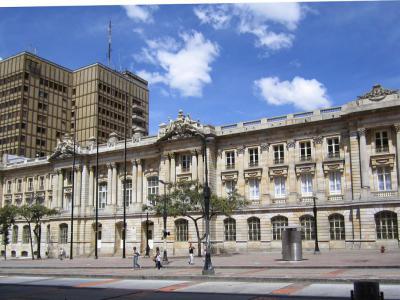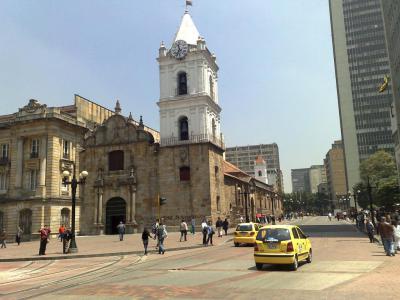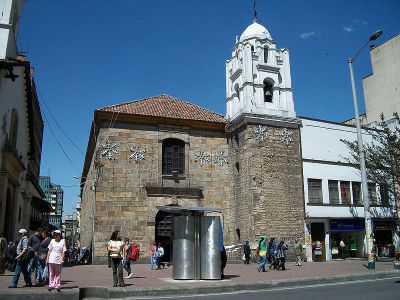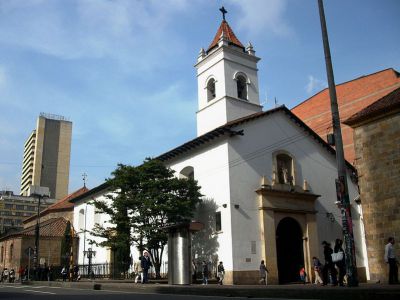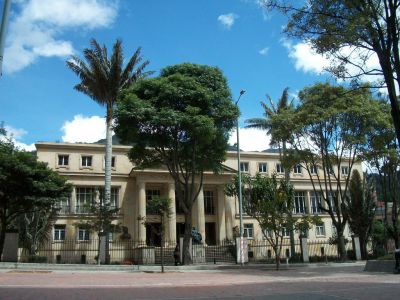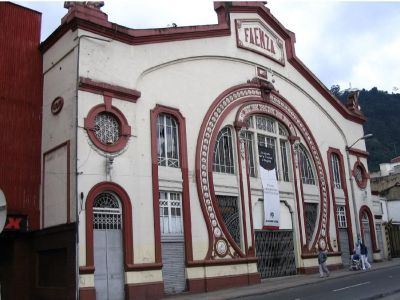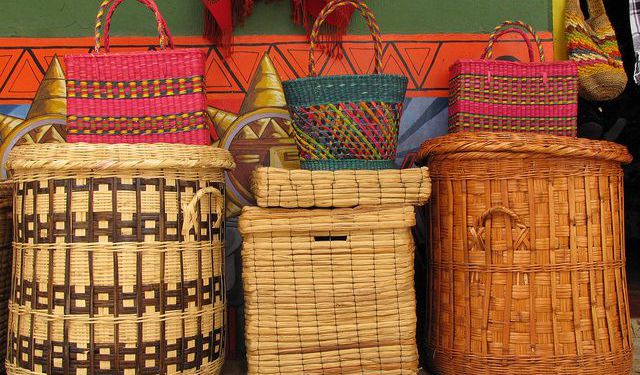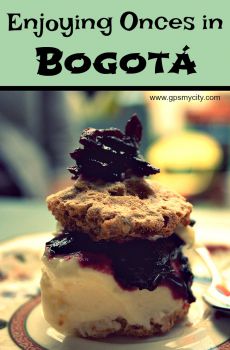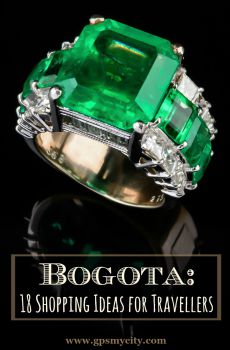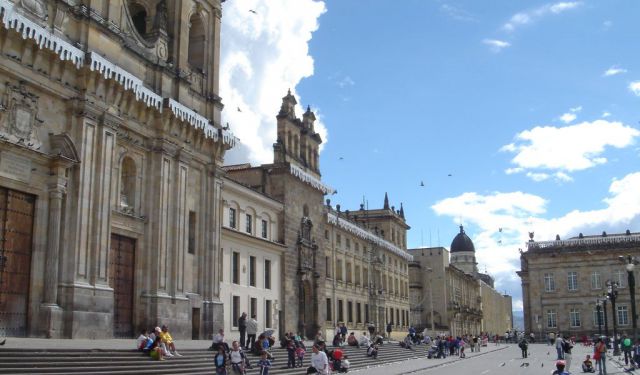
Architectural Jewels (Self Guided), Bogota
Bogota, Colombia, is quite a city for an architectural experience. Attentive to the local historical heritage, the city has managed to preserve in full splendor most of its colonial buildings.
One such gem is the Palace (or House) of Nariño, the official residence of the President of Colombia. Its grandeur and historical significance make it a prominent landmark.
Not far away from it stands the National Sanctuary of Our Lady of Carmen, a symbol of religious devotion and architectural beauty. Renowned for its architectural fusion of Florentine Gothic, Byzantine, and Arabic styles, this sanctuary is a National Monument.
Further enriching Bogotá's architectural landscape is the Christopher Columbus Theatre (Teatro Cristóbal Colón), named so after the famed explorer.
The Palace of San Carlos, the San Ignacio Church, and the College of San Bartolome are additional architectural marvels, each with its unique story to tell. The Liévano Palace, the National Capitol, and the San Francisco Palace exemplify the city's governmental institutions with their imposing facades and historical significance.
Religious fervor is also represented through structures like the Church of San Francisco, the Third Temple Church (Iglesia de la Tercera), and the Church of True Cross (Iglesia de la Veracruz), each contributing to Bogotá's spiritual tapestry.
Moreover, institutions like the Colombian Language Academy (Academia Colombiana de la Lengua) and Faenza Theatre add intellectual and artistic dimensions to the city's architectural wealth.
Bogotá's architectural jewels offer a glimpse into the city's past and present and invite exploration and appreciation. So, should you wish to discover the splendor of Bogotá's architectural heritage firsthand, venture forth on this self-guided walk.
One such gem is the Palace (or House) of Nariño, the official residence of the President of Colombia. Its grandeur and historical significance make it a prominent landmark.
Not far away from it stands the National Sanctuary of Our Lady of Carmen, a symbol of religious devotion and architectural beauty. Renowned for its architectural fusion of Florentine Gothic, Byzantine, and Arabic styles, this sanctuary is a National Monument.
Further enriching Bogotá's architectural landscape is the Christopher Columbus Theatre (Teatro Cristóbal Colón), named so after the famed explorer.
The Palace of San Carlos, the San Ignacio Church, and the College of San Bartolome are additional architectural marvels, each with its unique story to tell. The Liévano Palace, the National Capitol, and the San Francisco Palace exemplify the city's governmental institutions with their imposing facades and historical significance.
Religious fervor is also represented through structures like the Church of San Francisco, the Third Temple Church (Iglesia de la Tercera), and the Church of True Cross (Iglesia de la Veracruz), each contributing to Bogotá's spiritual tapestry.
Moreover, institutions like the Colombian Language Academy (Academia Colombiana de la Lengua) and Faenza Theatre add intellectual and artistic dimensions to the city's architectural wealth.
Bogotá's architectural jewels offer a glimpse into the city's past and present and invite exploration and appreciation. So, should you wish to discover the splendor of Bogotá's architectural heritage firsthand, venture forth on this self-guided walk.
How it works: Download the app "GPSmyCity: Walks in 1K+ Cities" from Apple App Store or Google Play Store to your mobile phone or tablet. The app turns your mobile device into a personal tour guide and its built-in GPS navigation functions guide you from one tour stop to next. The app works offline, so no data plan is needed when traveling abroad.
Architectural Jewels Map
Guide Name: Architectural Jewels
Guide Location: Colombia » Bogota (See other walking tours in Bogota)
Guide Type: Self-guided Walking Tour (Sightseeing)
# of Attractions: 14
Tour Duration: 2 Hour(s)
Travel Distance: 3.7 Km or 2.3 Miles
Author: Tom
Sight(s) Featured in This Guide:
Guide Location: Colombia » Bogota (See other walking tours in Bogota)
Guide Type: Self-guided Walking Tour (Sightseeing)
# of Attractions: 14
Tour Duration: 2 Hour(s)
Travel Distance: 3.7 Km or 2.3 Miles
Author: Tom
Sight(s) Featured in This Guide:
- Palacio de Nariño (House of Nariño)
- National Sanctuary of Our Lady of Carmen
- Teatro Cristóbal Colón (Christopher Columbus Theatre)
- Palacio de San Carlos
- Iglesia de San Ignacio (Church of San Ignacio)
- Colegio San Bartolome (College of San Bartolome)
- Palacio Liévano (Liévano Palace)
- Capitolio Nacional (The National Capitol)
- Palacio de San Francisco (San Francisco Palace)
- Iglesia de San Francisco (Church of San Francisco)
- Iglesia de la Tercera (Third Temple Church)
- Iglesia de la Veracruz (Vera Cruz Church)
- Academia Colombiana de la Lengua (Colombian Academy of Language)
- Teatro Faenza (Faenza Theatre)
1) Palacio de Nariño (House of Nariño)
Casa de Nariño (Spanish for House of Nariño) or Palacio de Nariño (Spanish for Palace of Nariño) is the official home and principal workplace of the President of Colombia. It houses the main office of the executive branch and is located in the capital city of Bogotá. In 1908, it was dedicated after being constructed on the site of the house where Antonio Nariño was born. The design was made by architects Gaston Lelarge, a French-born former pupil of Charles Garnier, and Julián Lombana. In 1980, the structure was rededicated after the construction of additions. The palace also houses works of art and furnishings from different years. Its garden houses the Observatorio Astronómico de Bogotá, designed by the Capuchin friar-architect Fray Domingo de Petrés and built in 1802-03.
Sight description based on Wikipedia.
2) National Sanctuary of Our Lady of Carmen
The National Sanctuary of Our Lady of Carmen (Santuario Nacional de Nuestra Señora del Carmen) is a temple of the Catholic cult dedicated to the Virgin Mary under the name of Carmen. It is located in barrio La Candelaria, the historic sector of Bogotá. The temple was designed by architect Giovanni Salesian Buscaglione with Florentine Gothic, Byzantine and Arabic touches. The building has three naves and a Latin cross plan. For its historical significance, originality, invaluable architectural value and artistic treasures, the shrine (with the Salesians of Leo XIII) was declared a National Monument by Decree 804 on April 30, 1993. Today, it is a symbol of Salesian community building and architecture.
3) Teatro Cristóbal Colón (Christopher Columbus Theatre)
The Teatro de Cristóbal Colón (The Chistopher Columbus Theatre), also known as the "Teatro Colón", is located in Bogotá and it is the nation's National Theatre.
It was built in the Neoclassical style by the Italian architect Pietro Cantini in 1885 and inaugurated on 27 October 1892 on the occasion of the fourth centenary of the discovery of America with a performance of Verdi's Ernani. The auditorium was constructed in the tradition horseshoe-shape and modelled on the layout of the Palais Garnier in Paris, but only about half the size. The Colón Theatre was declared a National Monument on 11 August 1975.
It was built in the Neoclassical style by the Italian architect Pietro Cantini in 1885 and inaugurated on 27 October 1892 on the occasion of the fourth centenary of the discovery of America with a performance of Verdi's Ernani. The auditorium was constructed in the tradition horseshoe-shape and modelled on the layout of the Palais Garnier in Paris, but only about half the size. The Colón Theatre was declared a National Monument on 11 August 1975.
Sight description based on Wikipedia.
4) Palacio de San Carlos
The San Carlos Palace, also known as Cancilleria, was built in the XVIth century upon the order of Francisco Porras Mejia, Archdeacon of the Cathedral. The San Carlos Palace has an indisputable and invaluable artistic and cultural legacy accumulated over 400 years of its history. The second floor of the Palace is accessed by a wide corridor of stairs in which a collection of bronze statues sculpted by Italian artist Pietro Tenerani are displayed. The palace is located at the corner of Calle 10 and Carrera 5.
5) Iglesia de San Ignacio (Church of San Ignacio)
The Church of San Ignacio was the biggest church during the colonial period. Its construction lasted from 1610 till 1767. The architect of the church of San Ignacio was Father Juan Bautista Coluccini (1604-1641), a Jesuit priest of the Society of Jesus. Jesuit brothers Pedro Perez, Rafael Ramirez, Diego Marcos Guerra and Loessing, the last author of many of the altars, tabernacles, pulpit and choir clad and brokers, collaborated with him in the construction.
6) Colegio San Bartolome (College of San Bartolome)
Foundation College of San Bartolome is Colombia's oldest college. It was founded on September 27, 1604 by the Archbishop of Bogota Bartolomé Lobo Guerrero and some Jesuits: Joseph Dadey , Martin de Funes, Coluccini Jaun Bautista Martin Torres and Bernabé de Rojas. The school is home to a Cultural and National Monument and is located at the southeast corner of Plaza de Bolivar in front of congress. The building itself has an important historic and architectural value, being a prominent landmark of Bogota.
7) Palacio Liévano (Liévano Palace)
Located on the western side of Plaza de Bolivar in Bogota, Liévano Palace represents French Renaissance style and was designed by French architect Gastón Lelarge on behalf of engineer Indalecio Liévano. The constructions were completed in 1907. The building has three levels and a patio where stands a bust of the hero Santander José Acevedo y Gómez.
8) Capitolio Nacional (The National Capitol)
Capitolio Nacional (or The National Capitol) is a building on Bolivar Square in central Bogotá, the construction of which began in 1876, by order of president Tomás Cipriano de Mosquera, and was not concluded until 1926. It houses both houses of Congress of Colombia. In 1947, for the Inter American Conference, Master Santiago Martínez Delgado painted a majestic mural under the commission of the then director of the OEA, Honorable Alberto Lleras Camargo and Conference organizer the Honourable Laureano Gómez--two men who later became Presidents of Colombia. This mural of the Elliptic chamber National Congress Building, made in the fresco style, represents Bolivar and Santander exiting the Cucuta congress during the creation of the Great Colombia. The mural is considered the most important fresco in the country and the artist's main masterpiece.
Sight description based on Wikipedia.
9) Palacio de San Francisco (San Francisco Palace)
The San Francisco Palace amazes with a sober and elegant Republican architectural style, and surprises even more with its rich and detailed interior decor. The construction of the building lasted from 1918 until 1933 following the project of the Gaston Lelarge. As of 1984, the palace has been listed as a national monument. Currently the building houses the Rosario school.
10) Iglesia de San Francisco (Church of San Francisco)
The church of San Francisco is a Catholic temple of worship under the protection of St. Francis of Assisi in the city of Bogotá, Colombia. This church was built between 1550 and 1567 on the right bank of the river Vicachá (later better known as San Francisco River) by the Franciscan brothers. It is currently the oldest church preserved in Bogotá and is nestled on the corner of Avenida Jimenez and Carrera 7.
11) Iglesia de la Tercera (Third Temple Church)
Also known as the Third Temple, the church is considered a jewel of colonial religious architecture in Bogota. Some say that the name "The Third" is because of the three churches located in that region: San Francisco, La Veracruz and La Tercera, but in fact its name comes from the founders of the Franciscan Third Order Secular. Its construction began in 1760 and was completed between 1774 and 1780, according to Daniel Ortega and Ricaurte.
12) Iglesia de la Veracruz (Vera Cruz Church)
One of the first churches built by the conquistadors in Santa Fe was the chapel of Veracruz, established in 1546, 8 years after the founding of Bogota, on the other side of the river Viracocha, on the road to Tunja. Years later, in 1631, he formed the Market Square San Francisco (now Santander park), which was extended by the Hermandad (Brotherhood) de la Veracruz, composed of merchants. The 1827 earthquake destroyed much of it and it was rebuilt. The church is not an example of fine architecture or a subject of great historic interest, yet here lie the remains of many patriotic martyrs, so it was declared a National Pantheon.
13) Academia Colombiana de la Lengua (Colombian Academy of Language)
The Academia Colombiana de la Lengua (Spanish for Colombian Academy of Language) is an association of academics and experts on the use of the Spanish language in Colombia. It is a member of the Association of Spanish Language Academies, being the oldest member from the Americas.
Founded in 1871 by a group of writer and philology specialist, including Manuel María Mallarino and Rufino José Cuervo, the father of Hispanic-American philology, and Miguel Antonio Caro, the Academia Colombiana de la Lengua is the first official Spanish language Academy to be founded outside of Spain. It is based in Bogotá. Since 1960 it officially assesses the Colombian government in language affairs and has obtained the passing of several regulations and laws favoring the Spanish language in the nation. Also in 1960 it hosted the third Congress of the Academies, in which the Bogotá Agreement was presented and signed.
Founded in 1871 by a group of writer and philology specialist, including Manuel María Mallarino and Rufino José Cuervo, the father of Hispanic-American philology, and Miguel Antonio Caro, the Academia Colombiana de la Lengua is the first official Spanish language Academy to be founded outside of Spain. It is based in Bogotá. Since 1960 it officially assesses the Colombian government in language affairs and has obtained the passing of several regulations and laws favoring the Spanish language in the nation. Also in 1960 it hosted the third Congress of the Academies, in which the Bogotá Agreement was presented and signed.
Sight description based on Wikipedia.
14) Teatro Faenza (Faenza Theatre)
Dating back to 1924, the theatre was built on the premises of an old factory called Faenza, hence the name. The building has a very attractive exterior design with an Italian influence. The design also features architectural expressions of 'Art Nouveau' and academic eclecticism of the late nineteenth century.
Walking Tours in Bogota, Colombia
Create Your Own Walk in Bogota
Creating your own self-guided walk in Bogota is easy and fun. Choose the city attractions that you want to see and a walk route map will be created just for you. You can even set your hotel as the start point of the walk.
Bogota Old Town Walking Tour
In 1538, the indigenous Muisca of the Colombian Altiplano had the advantage in numbers over the force of conquistador Gonzalo Jimenez de Quesada. Arriving in the Muisca Federation, the Spanish had only 162 exhausted men. However, the guecha warriors of Chief Tisquesusa were no match. The Federation fell in bloody battle.
In the area now known as Quevedo's Fountain Square, Quesada set up 12... view more
Tour Duration: 2 Hour(s)
Travel Distance: 4.1 Km or 2.5 Miles
In the area now known as Quevedo's Fountain Square, Quesada set up 12... view more
Tour Duration: 2 Hour(s)
Travel Distance: 4.1 Km or 2.5 Miles
Bogota Shopping Tour
Colombia is known for its gold and emeralds, recognizable national clothing, pottery, accessories, and other crafts. The country's capital Bogota is so rich in authentic shopping that it's almost mind-boggling to decide what to buy first and most importantly, where to buy it at the best possible price!
Start your quest at Pasaje Rivas Market, Bogota's oldest marketplace, offering... view more
Tour Duration: 1 Hour(s)
Travel Distance: 2.3 Km or 1.4 Miles
Start your quest at Pasaje Rivas Market, Bogota's oldest marketplace, offering... view more
Tour Duration: 1 Hour(s)
Travel Distance: 2.3 Km or 1.4 Miles
Useful Travel Guides for Planning Your Trip
Enjoying Onces in Bogota
Elevenses, on the surface, seem to be a particularly British tradition, a break for something light and sweet between breakfast and lunch, a time to gossip, a time to catch up, a time just to be. Lo and behold, Colombia somewhere along the line adapted this tradition in a particularly Latin fashion....
18 Uniquely Columbian Things to Buy in Bogota
To those who understand Russian, the word "Bogota" sounds very similar to the one translating as "rich". And, indeed, the city does live up to this name connotation in terms of peculiar things worth exploring in addition to coca, coffee and emeralds. Here's the longer list...
The Most Popular Cities
/ view all
